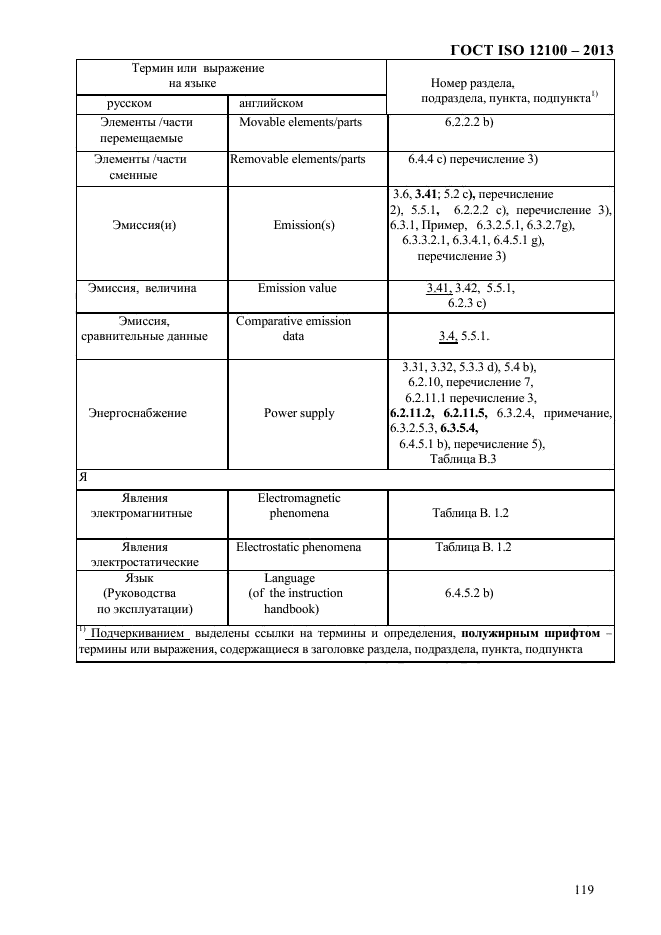Normativa En Iso 12100 Standard

Safety of machinery - General principles for design - Risk assessment and risk reduction (ISO 12100:2010)
This English language version of British Standard EN ISO 12100-1:2003 (BS EN ISO 12100-1:2003) is Part 2 of a series of documents covering about the application of fire engineering principles to the design of buildings. Part 2 examines the spread of smoke and toxic gases within and beyond the enclosure of origin (Sub-system 2).
Seguridad de las máquinas. Principios generales para el diseño. Evaluación del riesgo y reducción del riesgo. (ISO 12100:2010)
| Standard number: | UNE EN ISO 12100:2012 |
| Pages: | 88 |
| Released: | 2012-05-23 |
- 01.040.13
- 13.110
- 13.100
UNE standards
01.040.13 Environment and health protection. Safety (Vocabularies)
13.100 Occupational safety. Industrial hygiene
13.110 Safety of machinery
ISO specifies basic terminology, principles and a methodology for achieving safety in the design of machinery. It specifies principles of risk assessment and risk reduction to help designers in achieving this objective. These principles are based on knowledge and experience of the design, use, incidents, accidents and risks associated with machinery. Procedures are described for identifying hazards and estimating and evaluating risks during relevant phases of the machine life cycle, and for the elimination of hazards or sufficient risk reduction.
Guidance is given on the documentation and verification of the risk assessment and risk reduction process. ISO is also intended to be used as a basis for the preparation of type-B or type-C safety standards.
It does not deal with risk and/or damage to domestic animals, property or the environment. Automatic Cable Manager 12 Activator Rar Download.
Vintage Bianchi Serial Number. ISO 12100 Safety of machinery - General principles for design - Risk assessment and risk reduction. BS EN ISO Safety of machinery. General principles for design. Risk assessment and risk reduction. Standard by British Standard / European Standard.
Jeremy Procter, Convenor of the European Standards Committee responsible for Machine Guards, and Managing Director of Procter Machinery Guarding, discusses parts 1 and 2 of EN ISO 12100, the machinery safety standard. [ Note that EN ISO 12100-1 and EN 12100-2 have both been superseded by - Ed, 31 December 2010] EN ISO 12100 Safety of machinery - Basic concepts, general principles for design is one of the most important machinery safety standards.
It is harmonised to the Machinery Directive, so complying with its requirements (and those of other relevant harmonised standards) will generally be the shortest route to demonstrating that the Essential Health and Safety Requirements of the Directive have been met. EN ISO 12100 consists of two parts; Part 1 deals with Basic terminology, methodology and Part 2 is the Technical principles. Each part states that the other is 'indispensable for the application of this document.' EN ISO 12100-1:2003 and EN ISO 12100-2:2003 are Type A standards (basic safety standards) and therefore have a dual purpose: they are for use when designing machinery and they are also for use in developing Type B and Type C standards. Note, however, that a Type B standard (eg EN ISO 13849-1, Safety of machinery, Safety-related parts of control systems, Part 1: General principles for design) or a Type C standard (eg BS56 Specification for continuous mechanical handling equipment - Safety requirements, conveyors and elevators with chain elements - Examples for guarding of nip points) takes precedence if it deviates from any provision within EN ISO 12100-2 or any other applicable Type A standard. Both parts of EN ISO 12100 also recommend that the standard be incorporated in training courses and manuals to 'convey basic terminology and general design methods to designers.'
This power-to-weight ratio calculator provides a quick and easy way to determine the power-to-weight ratio (PWR) of any vehicle. You can calculate a PWR in four simple steps: Click on the 'Calculate PWR' button to generate the PWR. The power-to-weight ratio represents the ratio between a vehicle's power and its total weight. Power to weight ratio calculator. The Power to Weight Ratio (PWR) is the standard that most cyclists use to measure their fitness and improvement. It is easily calculated by dividing your weight (in kilograms) by your average power output (in watts). Most cyclists use their FTP for their power input to calculate their PWR for an hour (or a standard criterium). Power to weight ratio is used to measure the actual performance of any engine or power source as a whole. It is equal to thrust per unit mass multiplied by the velocity of any vehicle. This online vehicle horsepower to weight ratio calculator will in comparison of units or designs from one unit to the other.
EN ISO 12100-1 Looking in detail at Part 1, there are three main clauses in addition to the scope and normative references. Clause 3 of EN ISO 12100-1, extending to around seven pages, is devoted to terms and definitions. Password for administrator windows 10. This covers everything from 'machinery', 'hazard' and 'risk' to 'adequate risk reduction', 'common cause failures' and 'common mode failures.' Although Clause 3 does not contain a formal definition of a machine's lifecycle, Clause 5.3 explains this in some detail. Clause 4, 'Hazards to be taken into account when designing machinery,' can be treated as an extensive checklist of hazards, ranging from mechanical, electrical and thermal hazards to hazards generated by noise, vibration and 'neglecting ergonomic principles in machine design.'